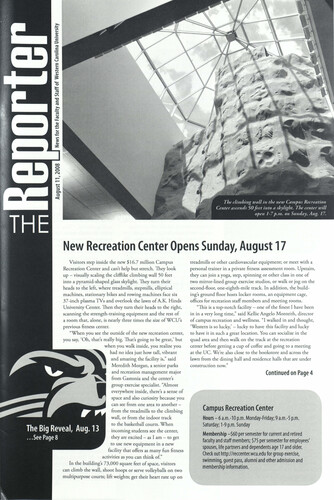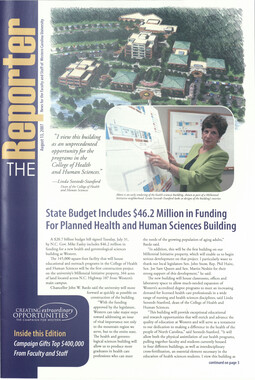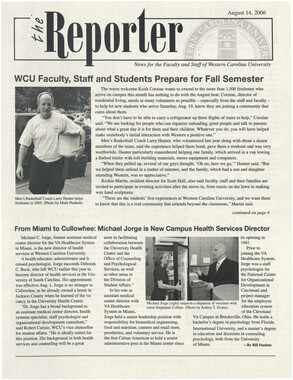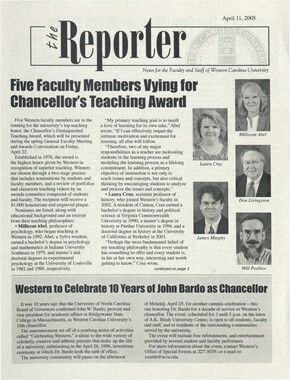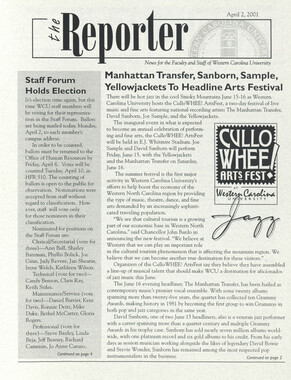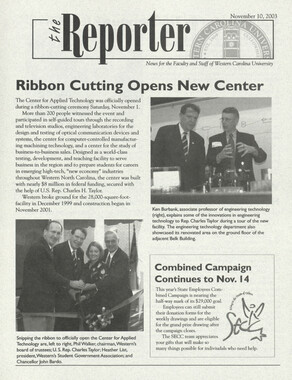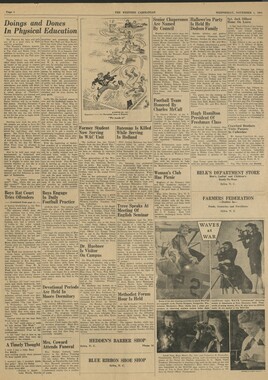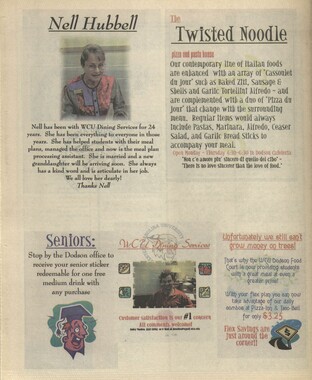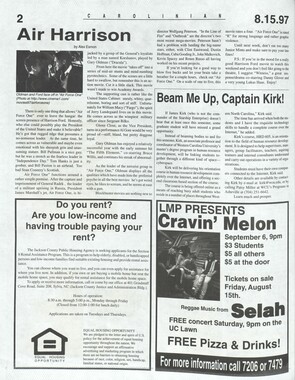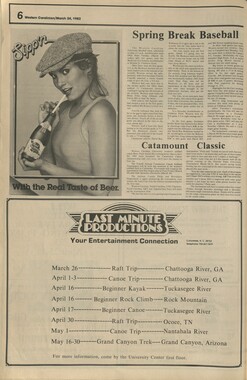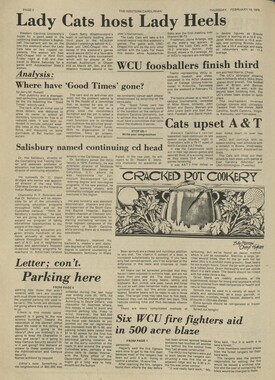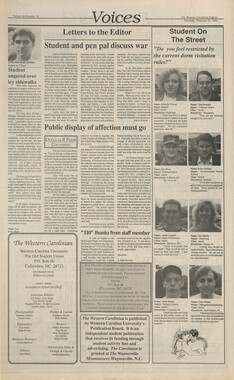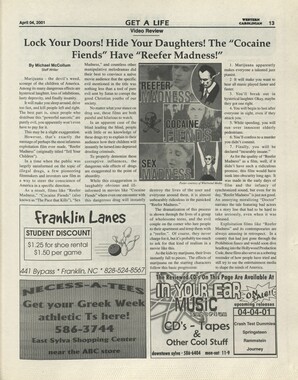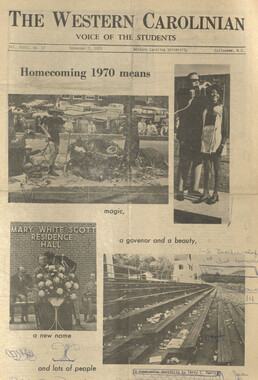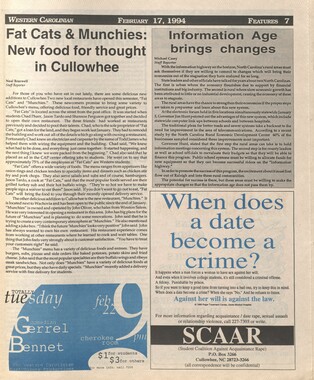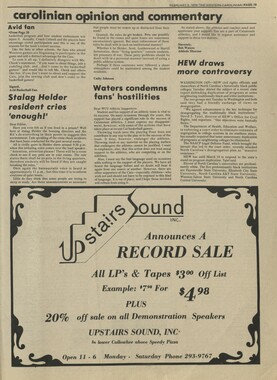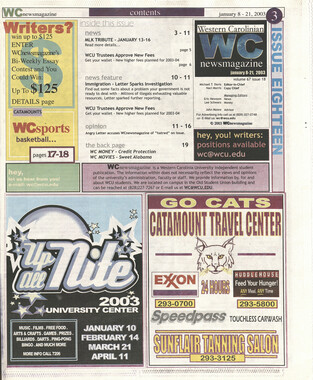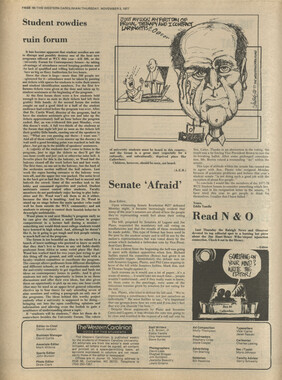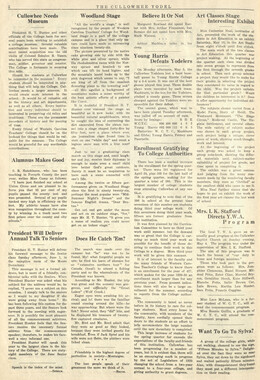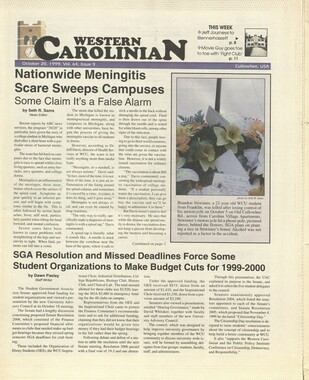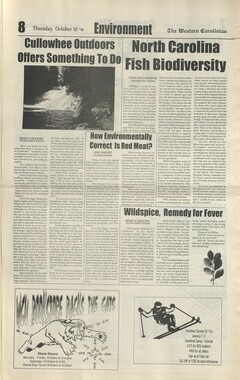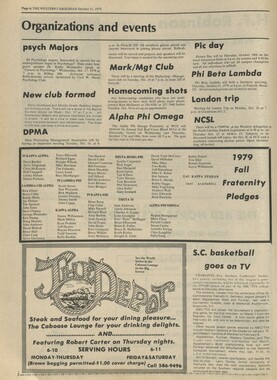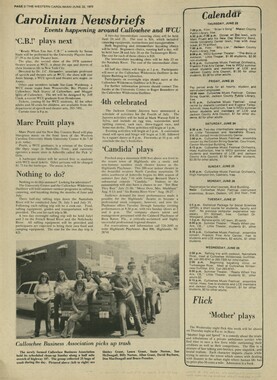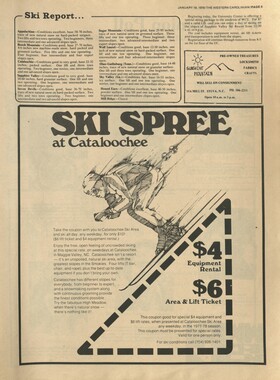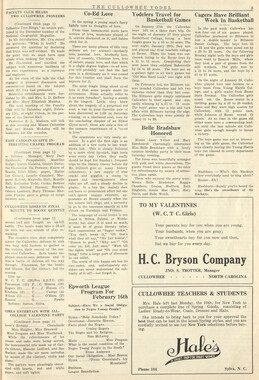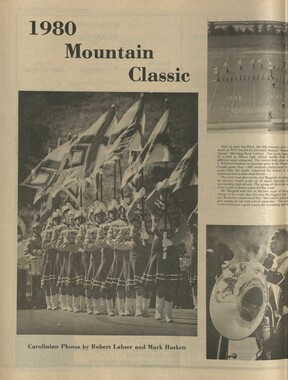Western Carolina University (1)
View all
- Western Carolina University Publications (2)
- Canton Champion Fibre Company (0)
- Cherokee Traditions (0)
- Civil War in Southern Appalachia (0)
- Craft Revival (0)
- Great Smoky Mountains - A Park for America (0)
- Highlights from Western Carolina University (0)
- Horace Kephart (0)
- Journeys Through Jackson (0)
- LGBTQIA+ Archive of Jackson County (0)
- Oral Histories of Western North Carolina (0)
- Picturing Appalachia (0)
- Stories of Mountain Folk (0)
- Travel Western North Carolina (0)
- Western Carolina University Fine Art Museum Vitreograph Collection (0)
- Western Carolina University Herbarium (0)
- Western Carolina University: Making Memories (0)
- Western Carolina University Restricted Electronic Theses and Dissertations (0)
- Western North Carolina Regional Maps (0)
- World War II in Southern Appalachia (0)
University of North Carolina Asheville (0)
View all
- Faces of Asheville (0)
- Forestry in Western North Carolina (0)
- Grove Park Inn Photograph Collection (0)
- Isaiah Rice Photograph Collection (0)
- Morse Family Chimney Rock Park Collection (0)
- Picturing Asheville and Western North Carolina (0)
- Western Carolina University (2)
- Allanstand Cottage Industries (0)
- Appalachian National Park Association (0)
- Bennett, Kelly, 1890-1974 (0)
- Berry, Walter (0)
- Brasstown Carvers (0)
- Cain, Doreyl Ammons (0)
- Carver, George Washington, 1864?-1943 (0)
- Cathey, Joseph, 1803-1874 (0)
- Champion Fibre Company (0)
- Champion Paper and Fibre Company (0)
- Cherokee Indian Fair Association (0)
- Cherokee Language Program (0)
- Crittenden, Lorraine (0)
- Crowe, Amanda (0)
- Edmonston, Thomas Benton, 1842-1907 (0)
- Ensley, A. L. (Abraham Lincoln), 1865-1948 (0)
- Fromer, Irving Rhodes, 1913-1994 (0)
- George Butz (BFS 1907) (0)
- Goodrich, Frances Louisa (0)
- Grant, George Alexander, 1891-1964 (0)
- Heard, Marian Gladys (0)
- Kephart, Calvin, 1883-1969 (0)
- Kephart, Horace, 1862-1931 (0)
- Kephart, Laura, 1862-1954 (0)
- Laney, Gideon Thomas, 1889-1976 (0)
- Masa, George, 1881-1933 (0)
- McElhinney, William Julian, 1896-1953 (0)
- Niggli, Josephina, 1910-1983 (0)
- North Carolina Park Commission (0)
- Osborne, Kezia Stradley (0)
- Owens, Samuel Robert, 1918-1995 (0)
- Penland Weavers and Potters (0)
- Rhodes, Judy (0)
- Roberts, Vivienne (0)
- Roth, Albert, 1890-1974 (0)
- Schenck, Carl Alwin, 1868-1955 (0)
- Sherrill's Photography Studio (0)
- Smith, Edward Clark (0)
- Southern Highland Handicraft Guild (0)
- Southern Highlanders, Inc. (0)
- Stalcup, Jesse Bryson (0)
- Stearns, I. K. (0)
- Thompson, James Edward, 1880-1976 (0)
- United States. Indian Arts and Crafts Board (0)
- USFS (0)
- Vance, Zebulon Baird, 1830-1894 (0)
- Weaver, Zebulon, 1872-1948 (0)
- Western Carolina College (0)
- Western Carolina Teachers College (0)
- Western Carolina University. Mountain Heritage Center (0)
- Whitman, Walt, 1819-1892 (0)
- Wilburn, Hiram Coleman, 1880-1967 (0)
- Williams, Isadora (0)
- Jackson County (N.C.) (2)
- Appalachian Region, Southern (0)
- Asheville (N.C.) (0)
- Avery County (N.C.) (0)
- Blount County (Tenn.) (0)
- Buncombe County (N.C.) (0)
- Cherokee County (N.C.) (0)
- Clay County (N.C.) (0)
- Graham County (N.C.) (0)
- Great Smoky Mountains National Park (N.C. and Tenn.) (0)
- Haywood County (N.C.) (0)
- Henderson County (N.C.) (0)
- Knox County (Tenn.) (0)
- Knoxville (Tenn.) (0)
- Lake Santeetlah (N.C.) (0)
- Macon County (N.C.) (0)
- Madison County (N.C.) (0)
- McDowell County (N.C.) (0)
- Mitchell County (N.C.) (0)
- Polk County (N.C.) (0)
- Qualla Boundary (0)
- Rutherford County (N.C.) (0)
- Swain County (N.C.) (0)
- Transylvania County (N.C.) (0)
- Watauga County (N.C.) (0)
- Waynesville (N.C.) (0)
- Yancey County (N.C.) (0)
- Newsletters (1)
- Publications (documents) (1)
- Aerial Photographs (0)
- Aerial Views (0)
- Albums (books) (0)
- Articles (0)
- Artifacts (object Genre) (0)
- Bibliographies (0)
- Biography (general Genre) (0)
- Cards (information Artifacts) (0)
- Clippings (information Artifacts) (0)
- Crafts (art Genres) (0)
- Depictions (visual Works) (0)
- Design Drawings (0)
- Drawings (visual Works) (0)
- Envelopes (0)
- Facsimiles (reproductions) (0)
- Fiction (general Genre) (0)
- Financial Records (0)
- Fliers (printed Matter) (0)
- Glass Plate Negatives (0)
- Guidebooks (0)
- Internegatives (0)
- Interviews (0)
- Land Surveys (0)
- Letters (correspondence) (0)
- Manuscripts (documents) (0)
- Maps (documents) (0)
- Memorandums (0)
- Minutes (administrative Records) (0)
- Negatives (photographs) (0)
- Newspapers (0)
- Occupation Currency (0)
- Paintings (visual Works) (0)
- Pen And Ink Drawings (0)
- Periodicals (0)
- Personal Narratives (0)
- Photographs (0)
- Plans (maps) (0)
- Poetry (0)
- Portraits (0)
- Postcards (0)
- Programs (documents) (0)
- Questionnaires (0)
- Scrapbooks (0)
- Sheet Music (0)
- Slides (photographs) (0)
- Songs (musical Compositions) (0)
- Sound Recordings (0)
- Specimens (0)
- Speeches (documents) (0)
- Text Messages (0)
- Tintypes (photographs) (0)
- Transcripts (0)
- Video Recordings (physical Artifacts) (0)
- Vitreographs (0)
- The Reporter, Western Carolina University (1)
- WCU Students Newspapers Collection (1)
- A.L. Ensley Collection (0)
- Appalachian Industrial School Records (0)
- Appalachian National Park Association Records (0)
- Axley-Meroney Collection (0)
- Bayard Wootten Photograph Collection (0)
- Bethel Rural Community Organization Collection (0)
- Blumer Collection (0)
- C.W. Slagle Collection (0)
- Canton Area Historical Museum (0)
- Carlos C. Campbell Collection (0)
- Cataloochee History Project (0)
- Cherokee Studies Collection (0)
- Daisy Dame Photograph Album (0)
- Daniel Boone VI Collection (0)
- Doris Ulmann Photograph Collection (0)
- Elizabeth H. Lasley Collection (0)
- Elizabeth Woolworth Szold Fleharty Collection (0)
- Frank Fry Collection (0)
- George Masa Collection (0)
- Gideon Laney Collection (0)
- Hazel Scarborough Collection (0)
- Hiram C. Wilburn Papers (0)
- Historic Photographs Collection (0)
- Horace Kephart Collection (0)
- Humbard Collection (0)
- Hunter and Weaver Families Collection (0)
- I. D. Blumenthal Collection (0)
- Isadora Williams Collection (0)
- Jesse Bryson Stalcup Collection (0)
- Jim Thompson Collection (0)
- John B. Battle Collection (0)
- John C. Campbell Folk School Records (0)
- John Parris Collection (0)
- Judaculla Rock project (0)
- Kelly Bennett Collection (0)
- Love Family Papers (0)
- Major Wiley Parris Civil War Letters (0)
- Map Collection (0)
- McFee-Misemer Civil War Letters (0)
- Mountain Heritage Center Collection (0)
- Norburn - Robertson - Thomson Families Collection (0)
- Pauline Hood Collection (0)
- Pre-Guild Collection (0)
- Qualla Arts and Crafts Mutual Collection (0)
- R.A. Romanes Collection (0)
- Rosser H. Taylor Collection (0)
- Samuel Robert Owens Collection (0)
- Sara Madison Collection (0)
- Sherrill Studio Photo Collection (0)
- Smoky Mountains Hiking Club Collection (0)
- Stories of Mountain Folk - Radio Programs (0)
- Venoy and Elizabeth Reed Collection (0)
- WCU Gender and Sexuality Oral History Project (0)
- WCU Mountain Heritage Center Oral Histories (0)
- WCU Oral History Collection - Mountain People, Mountain Lives (0)
- Western North Carolina Tomorrow Black Oral History Project (0)
- William Williams Stringfield Collection (0)
- Zebulon Weaver Collection (0)
- College student newspapers and periodicals (1)
- African Americans (0)
- Appalachian Trail (0)
- Artisans (0)
- Cherokee art (0)
- Cherokee artists -- North Carolina (0)
- Cherokee language (0)
- Cherokee pottery (0)
- Cherokee women (0)
- Church buildings (0)
- Civilian Conservation Corps (U.S.) (0)
- Dams (0)
- Dance (0)
- Education (0)
- Floods (0)
- Folk music (0)
- Forced removal, 1813-1903 (0)
- Forest conservation (0)
- Forests and forestry (0)
- Gender nonconformity (0)
- Great Smoky Mountains National Park (N.C. and Tenn.) (0)
- Hunting (0)
- Landscape photography (0)
- Logging (0)
- Maps (0)
- Mines and mineral resources (0)
- North Carolina -- Maps (0)
- Paper industry (0)
- Postcards (0)
- Pottery (0)
- Railroad trains (0)
- Rural electrification -- North Carolina, Western (0)
- School integration -- Southern States (0)
- Segregation -- North Carolina, Western (0)
- Slavery (0)
- Sports (0)
- Storytelling (0)
- Waterfalls -- Great Smoky Mountains (N.C. and Tenn.) (0)
- Weaving -- Appalachian Region, Southern (0)
- Wood-carving -- Appalachian Region, Southern (0)
- World War, 1939-1945 (0)
- Text (2)
- MovingImage (0)
- Sound (0)
- StillImage (0)
The Reporter, August 2008
-
The Reporter is a publication produced by Western Carolina University featuring news, events, and campus community updates for faculty and staff. The publication began in August of 1970 and continues digitally today. Click on the link in the “Related Mate
-
-
New Recreation Center Opens Sunday, August 17 Visitors step inside the new $16.7 million Campus Recreation Center and can't help but stretch. They look up- visually scaling the cliffiike climbing wall 50 feet into a pyramid-shaped glass skylight. They turn their heads to the left, where treadmills, stepmills, elliptical machines, stationary bikes and rowing machines face six 37-inch plasma TVs and overlook the lawn of A.K. Hinds University Center. Then they turn their heads to the right, scanning the strength-training equipment and the rest of a room that, alone, is nearly three times the size ofWCU's previous fitness center. "When you see the outside of the new recreation center, you say, 'Oh, that's really big. That's going to be great,' but when you walk inside, you realize you had no idea just how tall, vibrant and amazing the facility is," said Meredith Morgan, a senior parks and recreation management major from Gastonia and the center's group exercise specialist. "Almost everywhere inside, there's a sense of space and also curiosity because you can see from one area to another - from the treadmills to the climbing wall, or from the indoor track to the basketball courts. When incoming students see the center, they are excited - as I am - to get to use new equipment in a new facility that offers as many fun fitness activities as you can think of." In the building's 73,000 square feet of space, visitors can climb the wall, shoot hoops or serve volleyballs on two multipurpose courts; lift weights; get their heart rate up on treadmills or other cardiovascular equipment; or meet with a personal trainer in a private fitness assessment room. Upstairs, they can join a yoga, step, spinning or other class in one of two mirror-lined group exercise studios, or walk or jog on the second-floor, one-eighth-mile track. In addition, the building's ground floor hosts locker rooms, an equipment cage, offices for recreation staff members and meeting rooms. "This is a top-notch facility- one of the finest I have been in in a very long time," said Kellie Angelo Monteith, director of campus recreation and wellness. "I walked in and thought, 'Western is so lucky,' - lucky to have this facility and lucky to have it in such a great location. You can socialize in the quad area and then walk on the track at the recreation center before getting a cup of coffee and going to a meeting at the UC. We're also close to the bookstore and across the lawn from the dining hall and residence halls that are under construction now." Continued on Page 4 Campus Recreation Center Hours-6 a.m.-10 p.m. Monday-Friday; 9 a.m.-5 p.m. Saturday; 1-9 p.m. Sunday Membership - $60 per semester for current and retired faculty and staff members; $75 per semester for employees' spouses, life partners and dependents age 17 and older. Check out http://reccenter. wcu.edu for group exercise, swimming, guest pass, alumni and other admission and membership information. Freshmen Set to Roll into Campus Keith Corzine has been moving freshmen into residence halls for 20 years, bur his perspective changed two years ago after helping his oldest son set up home at the University of North Carolina at Wilmington. Corzine, Western's director of residential living, said he can sympathize now with parents who are leaving children in the hands of others. "You know parenrs are depending on other people to help their children with growth and development issues," Corzine said. Western faculty and staff can shoulder a small part of this big responsibility by volunteering to help the university's newest class get settled into their residence halls. Freshman move-in day begins at 7 a.m. Friday, Aug. 15. Even just a couple hours can have a big efFect on a new student's experience, Corzine said. "If I pulled up in front of a building and there was a professor or staff member there who thought enough of my experience Park It Traffic and parking changes for Friday, Aug. 15, include redirecting Scott and Walker residence hall employees to park in the H.F. Robinson building parking lot and solely accessing the lot from Centennial Drive. to help me unload my car- how committed is that?" he said. "Institutionally, it's positive if parents and studentS walk away with verification and validation that this big deci ion they made was the right one." Corzine is aiming for about 300 volunteers this year. There are roles for individuals who prefer not to lug heavy objects. They might hand our water, or use their knowledge of campus to offer directions. "We need those people just as much as somebody who can tote a small refrigerator up six Rights of stairs," said orzine, who named willingness as the premier quality he seeks in a volunteer. About I ,000 of the approximately I ,300 freshmen expected this fall will move into campus residence halls Aug. 15, Corzine said. This year, because of an expanded Western PEAKS residential transition program, approximately 90 percent of incoming residential freshmen will live in Scott and Walker halls, adjacent ro each other and located in cenrral campus. Volunteers will keep traffic Rowing at this a tiviry hub by unloading vehi les quickly at th urb. "Life will be much easier if everyone li tens ro the parking people who are directing," said Ernie Hudson, assistant chief of rhe University Police. Moves must be omplere by 5 p.m., when Fr hman onvocarion begin at Ram ey Regional A riviry enrer. onvo arion will include a faculty pro ession, r marks by hancellor John Bardo and Provost Kyle arrer, and music by W U's "Pride of the Mountain " Marching Band. Winford ordon, a p ychology professor, will speak to the freshmen about themes from their reading selection, "Three Cups of Tea," which chronicles author Greg Mortenson's mission to build more than 50 schools in Central Asia. - By JILL INGRAM OneS top Launches Web Site, Enhances Waiting Area The OneStop Service Center is offering a new Web site and playing music in the waiting area as part of recent improvementS designed to boost the quality and efficiency of customer experiences, said Mike Razdrh, associate director of the OneS top. Each day, the OneS top staff fields a few dozen to more than 1,000 questions, from inquiries about a particular charge on a bill to how to replace a lost CatCard. Fred Hinson, associate vice chancellor for academic affairs, said the mission of the 60 people who work as part of the OneS top team is to provide efficient and quality services to students when they have questions so that each student can have excellent WCU experiences. "Once a student enters Killian Annex and before he or she leaves the One Stop, the student should have an answer to his or her question or know what to do to receive an answer," said Hinson Staff members strive to direct students to a solution to the problem - whatever it is - within five to 10 minutes. If the OneS top adviser at the front counter can't answer the question, then the staff member refers the student to another specialist in Killian Annex, which also houses the ~ Reporter- August11, 2008 offices for financial aid, student accountS, CatCard, disability services, student support services, enrollment management, registrar, career services, advising center and orientation programs. The new onestop.wcu.edu Web sire launched this summer links studentS directly to the Web pages for those offices and an array of campus information, including a campus map, the academic calendar, a list of scholarships and campus shuttle details. The site also links studentS to online services that allow them to add money to their CatCash balance or complete the Free Application for Federal Student Aid. To offer additional access to the OneSrop's Web sire and other computer services during the opening of the fall semester, the center is temporarily adding seven more computers in Killian Annex room 136 to supplement the three that are always publicly available in the lobby. Recent physical enhancements to the OneStop include installation of a new sound system in the waiting area, an electronic information sign and card-readers at the counter for tracking the number of people served. The sound system plays musical hies from the 1970s to today as a way to entertain waiting customers and provide privacy for clientS who are being helped at the counter. The new sign will display reminders for studentS such as registration dates or commencement information. The changes follow the relocation of several offices in Killian Annex last year that shifted the most frequently visited offices, such as financial aid, from the second Roor to the first floor. Also, the move of the Catamount Academic Tutoring Center out of Killian Annex to Hunter Library created additional room that has been renovated for expanded CatCard services. "Our recent improvementS have been met with very positive responses by both studentS and staff," said Razdrh. "It has not only created a more customer-friendly environment, but also improved the workplace for staff. I would like to encourage faculty, staff and studentS to explore our Web site and become familiar with it. It should be easier to locate the OneSrop service areas through this site. There also is an evaluation form on the Web site that allows an opportunity to provide feedback for those that use our walk-in or phone services. Our goal is ro continue to provide quality services." - By TERESA KILLIAN Summer Research Program Offers Holistic Educational Experience Timothy Willis, a senior chemisrry major from Maiden, was sorry to see the summer end, bur nor because it was back-to-school time. After all, Willis spent his summer at school - at WCU - researching the "Isolation of Cytotoxic Compounds from Indigenous Plants of Western North Carolina" with Jason Clement, assistant professor of chemistry. What made the experience extraordinary for Willis, however, was not only the research opportunity bur also the personal experience of getting to know the faculty and students in WCU's Summer Undergraduate Research Fellowship program. Student participants lived together on campus and participated in lunch meetings and programs such as career workshops and sessions on resume development. Their experiences ranged from making formal research presentations before regional scientists at a summer conference to raking group hikes and attending chemistry department cookouts. "We calked, and not just about chemist.ry or school, bur also in-depth about the future of the country, politics, all areas of science, books, music and even religion sometimes," said Willis, who wants to pursue a career in the field of natural products chemistry. "It was refreshing." The goal of SURF was to provide an eight-week, total immersion research experience at WCU for eight students. The chemistry and physics faculty proposed it as part of an effort to incorporate the university's Quality Enhancement Plan into their program. The QEP commits the university to helping students have valuable learning experiences inside and outside the classroom and then reflect on those experiences in ways that prepare them to be "true citizens for life," said Carol Burton, assistant vice chancellor for undergraduate studies and QEP project director. "It's one thing to educate someone in an academic sense. It's another to go beyond and help prepare true citizens for life. The faculty who worked with the Summer Undergraduate Research Fellowship program truly went beyond to offer our students that higher level of educational experience." The chemistry and physics department is one of four academic areas selected to pilot the QEP this fall, and funding from the chancellor's and provost's offices is supporting endeavors such as the SURF program. To make the experience financially feasible for student participants, each received a $3,500 stipend, on-campus housing and a Quality Enhancement Plan In Action This Fall Students in eight to 10 classes will test the education briefcase described in the QEP. Four programs - chemistry and physics, history, recreation therapy and health information and administrationare piloting the QEP in specific classes or programs. Check out the draft ofWCU's application for the Carnegie Foundation for the Advancement of Teaching's community engagement classification at www.wcu.edu/engagement. meal plan. Faculty also received stipends. The department modeled the SURF program on the National Institute of Science and Technology's SURF program and the National Science Foundation's research experience for undergraduates program. "Research is a huge component of our curriculum, and I think it is the best form of teaching because it is totally discovery-based and allows for students to work one-on-one with faculty," said William Kwochka, associate professor of chemistry and the QEP coordinator for the chemistry and physics department. What sets SURF at WCU apart from other programs are the comprehensive assessment and reflection components designed to quantify what students have learned, and help participants reflect on the complete experience and how it relates to their plans for the future, said Kwochka. Mickey Yost, a senior clinical laboratory sciences major from Maggie Valley and SURF participant, wants to pursue a doctorate in microbiology. For SURF, Yost conducted research with Jack Summers, assistant professor of inorganic biochemistry, chat related to compounds proposed for anti-cancer treatments (more specifically, the inhibition of superoxide dismurase) and then presented their work to a private biotechnology company in Maryland. She said she learned a lor about their research topic, bur the most valuable parts of SURF, for her, were the friendships formed and interactions with faculry and fellow students. "I feel smart and validated to be able to say they are my peers," said Yost. "They accept me as one of them." - By TERESA KILLIAN ~ Reporter - August 11, zoos New Recreation Center Continued from Cover 1he opening of the new faci lity increases programming opportunities not only for the fitness program under the student affairs division, but also for academic departments such as health, physical education and recreation. Sharing space in Reid Gym created scheduling limitations for both. The fitness center used to close, for instance, from 8 a.m. to noon to allow classes to meet there. Now that won't be necessary. Membership and visitor fees will go up, however. "We're going to keep the costs to use the faci lity as low as we can because we believe physical fitness is important for everyone," said Monteith. "We are not a for-profit facility. We just need to pay our expenses." For students, the cost is included in student fees. For faculty and staff, memberships will be available for purchase each semester. Spouses and dependents of fu ll-time employees and students also will be eligible for memberships. The price will be based on the operating costs of the facility. To give everyone in the campus community a chance to check out and try the facility, access will be available for free in August to anyone who has a valid CatCard. The opening, Sunday, Aug. 17, comes nearly a decade after Chancellor John W. Bardo addressed student interest in a major indoor recreation center as part of a campus update and almost three years after the university broke ground on the project. At the formal ground-breaking, Bardo described the facility as a key part of the development ofWCU into a "true university community" - a community that students would feel connected to for the rest of their lives. "You do not create that Lifetime relationship just in the classroom," said Bardo at the center's groundbreaking. "You also create it through the activities that take place outside the classroom and through a sense of belonging to a community." - By TERESA KilLIAN ~ Reporter- August11 , 2008 CLIMBING WAll The 2, I 00-square-foot indoor climbing feature includes a rocklike arch for bouldering, a sport in which climbers attempt very short climbs, typically close to the ground. On the 50-foot vertical face, rock-shaped pieces called holds, which climbers grab, push or step on, will be reconfigured monthly to create new routes to the top. Base Camp Cullowhee is managing the wall and will schedule when it is open for use, as well as coordinate safety training and equipment, which includes ropes and harnesses. "Climbing provides an excellent fullbody muscular workout," said Josh Whitmore, director of Base Camp Cullowhee. "Balance and coordination is paramount in climbing, so fi ne motor skill development is also highlighted. The common misconception is that climbing ability comes from strong arms, but in reality, core conditioning is really the key." <11 oup I \t'} t/lt' \11{(/u, FITNESS AREA Fourteen treadmills, four stepmills, 12 elliptical machines, four rowing machines, eight stationary bikes, six spin bikes, six steppers, two recumbent cross trainers, a series of Cybex strength-training machines and free weights will be featured in a 9,800-square-foot fitness area. Cardio Theater will allow users to plug their own headphones into equipment and listen to TV or music. Special flooring will help cushion weights and reduce sound. Nearby are two private rooms for meeting with fitness trainers and conducting fitness assessments. INDOOR TRACK A three-lane indoor track upstairs at the recreation center extends one-eighth of a mile. The kidney-bean shaped route offers walkers and runners glimpses of the exercise studios, the climbing wall, the multipurpose courts and the fitness area. MULTIPURPOSE COURTS The side-by-side multipurpose courts, which have basketball hoops and striping for basketball and volleyball, can be divided. Electronic scoreboards and pull-out bleachers also are in place. GROUP EXERCISE STUDIOS Two exercise studios feature mirrored walls, built-in audio and microphone systems, and secure closers to store equipment. One studio has suspended hardwood and the other a specialized indoor sports flooring. Group classes will include yoga, Pi lares, spinning, aerobics and other forms of srrength training. The schedule for the semester will be released after the Group X Jam sampler event on Wednesday, Sept. 3. The studios will be open when not in use for classes or dance ream practices. MEETING AND CONFERENCE ROOMS Two meeting rooms offer space and equipment for training and possible expansion of courses such as cardiopulmonary resuscitation and first aid. BONUS FEATURES Two 50-inch plasma digital TVs, one on each floor, offer campus and recreation center information and announcements. The system upstairs will be interactive. The center also has security cameras and a public address system. POOL Although not part of the new building, recreation center staff members manage the pools. Over the summer, workers drained, acidwashed and regrouted the six-lane, 25-yard pool in Reid Gym. Old lights that used to hang over the pool have been replaced. Paint to match the new recreation center has added color to the formerly white walls. New amenities include purple and gold kickboards, shelving, cabinets, a pace clock and backstroke flags. "There's a more welcoming, lively ambiance now, and the pool itself appears cleaner," said Shauna Sage, assistant fitness director. ~ Reporter - August 11, zoos Newsfile Robert T. Berry, associate professor of emergency management, completed his professional recertification and earned the designation "lifetime Certified Emergency Manager.· "A Comparison of Service-learning and Employee Volunteering Programs; an article whose co-authors include Glenn Bowen, director of service learning, and Paul Jacques, assistant professor of management, has been accepted for publication in the Academy of Educational leadership Journal. Also, Bowen's article "Supporting a Grounded Theory with an AuditTrail: An Illustration; has been accepted for publication in the International Journal of Social Research Methodology: Theory & Practice. Christopher Cooper, director of the maste(s degree program in public affairs, will begin directing Western's Public Policy Institute as Gordon Mercer, the institute's founder and director for 10 years, enters phased retirement. The PPI strives to empower the region's residents and leaders to discuss and develop effective public policies. Oak Knoll Press recently published "The Paradox of Prosperity: The leiden Booksellers' Guild and the Distribution of Books in Early Modem Europe; by Laura Cruz, assistant professor of history. The publisher notes that the book explores the migration of printers from the Southern Netherlands to leiden and how a guild of printers became an instrument to exercise market power. Dottle Saxon Greene, assistant professor of social work, was elected to the N.C. Substance Abuse Professional Practice Board, which is the state's credentialing body for all substance abuse professionals. M. Scott Koger, Information Technology security analyst, co-authored "From Chalk and Talk to Online Offerings: Keeping Pace With Technology in Education; which was published in the International Journal of Management in Education. Koger co-presented "Defining Enterprise Computing: A New Model Proposal or the Death of the Intranet" at the Southwest Decision Sciences Institute's 2008 annual conference, and presented "Putting it in Play, Compliance - An Object-Oriented Approach" at the New York City Metro Chapter Information Systems Security Association meeting in June. James Seifers, associate dean of the College of Health and Human Sciences, was awarded the National Athletic Trainers' Association Service Award in St.louis at the association's annual meeting. The award is the third highest given by the organization. Ann Brett Strickland, assistant athletics director, was elected to the board of directors of the National Association of Collegiate Marketing Administrators at the association's 17th annual meeting in Dallas. John A. Williams, director of the forensic anthropology program, was re-elected to a three-year term as a member of the board of directors and treasurer of the American Board of Forensk Anthropology, the only certifying board in the field of forensk anthropology. Send news items to reporter@email.wcu.edu. ~ Reporter- August 11. 2008 Daughter of Two Employees Wins Staff Forum Scholarship Brittany Haskett grew up at Western tagging along with her parents, Tammy and Mark Haskett, to the conferences, events and games where they were working. The majority of her wardrobe is purple and gold, and she has rwice performed on the stage of the Fine and Performing Arts Center. She has even taken classes on campus as a dually enrolled student at Smoky Mountain High School, but it wasn't until Haskett decided to enroll full-time at WCU this fall that she truly felt like part of the university family. "I am looking forward to finally calling myself a Catamount," said Haskett, winner of the 2008 Staff Forum Scholarship. The scholarship is offered annually to help the children of non-faculty staff members afford to attend Western, and recipients are selected based on their involvement in activities, scholastic performance, financial need and personal essays about educational and career goals. Haskett has been involved in volleyball, student council, Fellowship of Christian Athletes, National Honor Society, Spirit Club and volunteer service, and her awards include National Anthem and Spanish awards. What particularly impressed the staff forum scholarship selection committee was her interest in using her education - a degree in construction management - for the good of humanity, said Lisa Frady, committee chair and academic adviser. "[ want to help people in need," said Haskett, who was drawn to the profession after volunteering with Habitat for Humanity and helping rebuild homes in Gulfport, Miss., as part of a hurricane relief effort. "I had no idea that one hurricane could do so much damage. When we drove through the town, everyone was silent." In the following days, Haskett helped put a roof on a house for a young family. When she returned a year later, she helped build a house from the ground up. "The combination of helping out people in need and feeling the satisfaction of a job well done was inspiring to me," said Haskett. She chose WCU after meeting the construction management faculty and taking classes at Western, and her parents are grateful for the scholarships that make it easier for their daughter to pursue her dream in Cullowhee. "She will be living on campus and I'm sure she will love it as much as her father (the university photographer} and l do," said Tammy Haskett, director of orientation programs. Frady urged members of the campus community to make a contribution to the scholarship fund. "It is our goal to increase the amount of the scholarship fund to include rwo awards, and that can only be possible with your help," she said. For more information, check out the Staff Forum Web site at www.wcu.edu/stforum. Haskett has received numerous other scholarships and grants including Western's Deborah J. Bardo Employee Scholarship, a $700 merit-based scholarship awarded to children or grandchildren ofWCU employees starting their first year at WCU, and a Kimmel Foundation Scholarship, which is awarded to students majoring in construction management at WCU's Kimmel School of Construction Management and Technology. - By TERESA KILLIAN Stage and Screen Gets New Department Head Thomas M. Salzman, past chair of the performing arts department at the College of Santa Fe, in July joined the WCU faculty as head of the stage and screen department. "We are excited about the wealth of knowledge Tom brings to Western, from his extensive experience in the professional world as a lighting designer, general manager, production manager and artistic director, to his experience in higher education as a teacher and administrator," said Robert Kehrberg, dean of the College of Fine and Performing Arts. "We offer the best of both worlds to our students when our CEO in stage and screen brings professional reality to the classroom and curriculum." Salzman, a native of Brecksville, Ohio, earned his bachelor's degree in theater arts in 1982 and his master's degree in lighting design in 1989, both from Carnegie Mellon University. His theater experience includes working as general manager and artistic associate for the Caldwell Theatre Company in Boca Raton, Fla., where he was responsible for a $2.2 million budget and tasks such as negotiating artist contracts and marketing. Also at the Caldwell, he served as artistic director for an outreach series that focused on creation of new plays and designed the lighting for more than 70 productions, two of which won Carbonell Awards for Best Lighting Design. "Lighting designers try to move the eye of the audience to where the director wants them to look, just as a filmmaker might zoom in for a close-up or out for a long shot," said Salzman. His experience in higher education includes teaching at Pennsylvania State University and the University of Miami, where he was head of design and production from 1991 to 1997. At the College of Santa Fe, Salzman developed and taught classes including "Theatre: Arts, Audience and the Critic" and an interdisciplinary class in playwriting that incorporated the theater, motion pictures and creative writing departments. His interest in the connections between stage and screen attracted him to WCU's merged department. "The next generation of theater and film artists and technicians will need to be prepared to work in a variety of mediums," said Salzman. "My primary goal for the next five years is to truly integrate stage and screen in a way that is unique to training programs in the country - in our productions and in our teaching methods and paradigms." Susan Brown-Strauss, who led the department prior to Salzman, will continue to serve as director of theater and dance programs. -By TERESA KILLIAN State Funding Includes $4 million for Education, Allied Professions Building The North Carolina budget for the 2008-09 fiscal year contains funding for new programs and projects at WCU, including $4 million to plan a new College of Education and Allied Professions building "This is a milestone for the college and all of its programs," said Michael Dougherty, dean of the college. "The planning money will allow the College of Education and Allied Professions to build upon its national reputation by planning a state-of-the-art facility that will allow us to prepare professionals for the 21st century, thus continuing our impact on the region, the state and the nation. The building will allow us to take our award-winning programs to the next level of excellence." Dougherty said faculty, staff and community partners will begin this year to develop a vision of what the building will look like and what it will enable faculty, staff and students to do. Other programs at WCU that received new funding include: - The forensic science program received an adtlitional $500,000 in recurring funding. Mark Wilson, director of the program, said the increase could help the program expand research opportunities, purchase equipment and hire new faculty. - The North Carolina Mathematics and Science Education Network's precollege program at WCU received $200,000 to expand programming. The program provides academic support and enrichment in science, technology, engineering and mathematics for Western North Carolina's midrlle and high school students. - Other areas funded include enrollment growth, campus safety, tlistinguished professorships and salary increases - merit-based EPA salary increases of 3 percent, and 2.75 percent salary increases or $1,100, whichever is greater, for SPA employees. Under Construction Forsyth Building Renovations - The $5 million renovation project is scheduled for completion Oct. 31, with College of Business faculty anticipating move-in afi:er the fall semester. The renovations bring the building into compliance with the Americans with Disabilities Act and update the interior with features from new lighting fixtures to paint. New Dining Hall - The $17.2 million facility to replace Dodson Dining Hall is scheduled for completion Nov. 25. The 53,000-square-foot, two-story building will host an "all-you-care-to-eat" venue with salads, fruits and vegetables, pastas and pizza, home-style foods, grilled items, sandwiches and dessertS and will include space for a Starbucks Coffee, McAlister's Deli, Panda Express, Grille Works, Freshens and Zoca Mexicanthemed restaurant. Windows will overlook campus and the mountains. - New Residence Halls - The first in a $50.2 million pair of residence halls under construction adjacent to the new tlining hall is scheduled for completion in July, and the second residence hall, to adjoin the first via an archway, is scheduled for completion in July 2010. The 235,000-square-foot buildings will house about 800 students, including participants in the Honors College and N.C. Teaching Fellows Program, and offices, lobbies, common areas and meeting rooms. Health and Human Sciences buildingPlanning continues for the $46.2 million College of Health and Human Sciences building. The facility will be built on a portion of the 344 acres across N.C. Highway 107 from the main campus as part of the Millennia! Initiative. The 145,000-square-foot building will house classrooms, office and laboratory space for a wide range of nursing and health sciences disciplines. Education and Allied Professions building- The state ofNorth Carolina's 2008-09 budget included $4 million to plan a $40 million College of Education and Allied Professions building. ~Reporter - August 11, 2008 7 ~Reporter 0. :---Augustll-24--------------------- Monday, August 77 Catamount women's soccer scrimmage - vs. Cincinnati. 7 p.m. CAC. (227-7338) Wednesday, August 73 Opening assembly - For faculty and staff. 8:30a.m. reception, 9 a.m. assembly. FAPAC. (227-7100) The Reveal - Unveiling of the new Catamount athletics logo. 4 p.m. RRAC. (227-7337) Thursday, August 74 Open faculty caucus - 3 p.m. Killian 104. (227-3800) Thursday, August 74-Sunday, August 77 Theater - "Laundry and Bourbon" and "Lone Star;' two one-act plays by James Mclure. 7:30p.m. ThursdaySaturday, 3 p.m. Sunday. NiggliTheatre. $. (631-2888) Friday, August 75 Residence halls open to freshmen - 7 a.m. (227-7303) Freshman Convocation - 5 p.m. RRAC. (227-7147) Saturday, August 76 Residence halls open to all students - 8 a.m. (227-7303) Freshman Assembly - 10 a.m. RRAC. (227-3621) Catamount women's soccer - Alumni scrimmage. 2 p.m. CAC. (227-7338) Valley Ballyhoo - Annual back-to-school celebration. 4:30p.m. UC lawn. (227-3621) Sunday, August 77 Campus Recreation Center opens - 1 p.m. (227-7234) Outdoor movie - "The Strangers."9 p.m. UC lawn. (227-7479) Monday, August 78 Fall semester - Classes begin at 8 a.m. (227-7495) KEY: $-Admission fee; BB- Belk Building; CAC-Catamount Athletic Center; CAT-Center for Applied Technology; CCB-Cordelia Camp Building; CSC-Catamount Softball Complex; FAPAC-Fine and Performing Arts Center; HA- Hoey Auditorium; HFR- H.f. Robinson Administration Building; Hl- Hunter library; HS/CF- Hennon Stadium/Childress Field; MHC- Mountain Heritage Center, NSANatural Sdences Auditorium; RH- Recital Hall, Coulter Building; RRAC-Ramsey Regional Activity Center; UC-A.K. Hinds University Center; WS/BW- Whitmire Stadium/Bob Waters Field. Submissions: Send news items, calendar notices and address changes ro Reporter@email.wcu.edu or WCU Calendar, 420 H.F. Robinson Building. Submit irems for The Reporter calendar at least four weeks prior ro rhe event. Picture Time Photos of new employees will be included in an upcoming issue of The Rc:portc:r dedicated to introducing newcomers to WCU. Full-time employees hired after Sc:pt. I, 2007, arc: invited to stop by the photo studio at 420 H .F. Robinson Building between I :30 and 4 p.m. Wednesday, Aug. 13, or 8 a.m. and 10 a.m. Thursday, Aug. 14. Exhibits Fine Art Museum "Fragile Earth: Reflections on the Environment"- Juried competition of new work in a variety of media by artists in WNC's eight westernmost counties and the Qualla Boundary. Through Saturday, Aug. 16. "Worldviews"- Selections from WCU's permanent collection. Ongoing. Hours: 10 a.m.-4 p.m. Tues.-Fri.; 1-4 p.m. Sat. (227-3591 or http://fapac.wcu.edu) Mountain Heritage Center "Stream of Life" - August slideshow spotlight "People of One Fire" - Cherokee pottery. Through Sunday, Nov. 16. Gallery B. "The Artistry of Plain-Style Furniture"- An exhibit of furniture handmade in Western North Carolina during the 1800s and early 1900s. Through Monday, Dec.15. Gallery C. "Migration of the Scotch-Irish People"- Permanent exhibit. Gallery A. Hours: 8 a.m.-5 p.m. Mon.-Fri. (227-7129 or http://www.wcu.edu/mhc) Hunter Library "Bartram's Journey: The 1775 Journey ofWilliam Bartram to Western North Carolina"- Through August. Ground floor. Plant specimens- Selections from the WCU herbarium. Through August. Main floor. Historic home exhibit- Story of the Zachary-Talbert House, built more than 150 years ago by one of the first white settlers of the Cashiers Valley. Through August. Main floor. (227-3398 or library.wcu.edu) Jason Emerson Brady Hunter Library Hunter Library Chancellor: WCU Must Focus on Academic Quality, Needs of N.C. As WCU gets ready to welcome the best prepared freshman class in its history, the university must focus attention in the coming year on aligning four separate yet related strategic activities so that it can continue to improve academic quality and serve the needs of the people of North Carolina. That was the message delivered to WCU faculty and staff by Chancellor John W. Bardo during his annual Opening Assembly address Wednesday, Aug. 13. Bardo told the crowd gathered in the Fine and Performing Arts Center that the incoming freshman class has a record average SAT score of 1039. That represents a 17-point increase over last's year's average SAT score of 1022 and a 74-point rise since 1995, when the average test score was 965. The high school grade point average for the typical entering student is 3.53, up from 2.78 in 1995. "We are seeing major improvements in the quality of the class," Bardo said. "The change in our SAT score is statistically significant. Generally, a change of six points is considered to represent a change in the student population. We are in a very different position than we were in 1995, and we have by far the best entering class in the history of the university." The significant climb in the average SAT score is one of several quality indicators that show Western is on the right track, he said. Others include the creation of the Honors College, growth in graduate student enrollment, an increase in the number of state-recognized endowed professorships from zero in 1995 to 19 this year, and a rise in the total number of applications received from prospective students from 3,312 in 1995 to about 7,440 in 2008. "Western today is not the same university it was in 1995, or even in 2001. Together, we have made great progress," Bardo said, attributing the institution's increasing quality to the hard work of its faculty and staff. "When you do the common things in life in an uncommon way, you will command the attention of the world," he said, quoting from George Washington Carver. "We are about teaching, scholarship and service - the fundamental activities of any university. But we are doing them in uncommon ways," Bardo said. "The path that we are on is very different than most other universities, and it is clear that we have an opportunity to strike out in a direction that could have far-reaching implications not just for us, bur for our state and for higher education in general." He compared Western's situation to climbing a mountain, with facu lty and staff having collected the equipment and supplies, built the base camp and identified the guides in preparation for the big ascent. "As a university, our climb involves implementing four highly intertwined strands that together form a very strong rope that can take us to the top of the mountain," Bardo said. Those strands, which must be the focus of faculty and staff in the 2008-09 academic year, he said, are: Quality Enhancement Plan - Western must begin to fully implement its QEP, a holistic approach that focuses on helping students integrate knowledge from different classes and co-curricular activities, and apply that knowledge in real-world settings. Bardo called upon academic leadership to develop a schedule so that all academic departments will have their own plans for the QEP in place by fall2011. Boyer Model- Western last year approved a new policy for faculty tenure, promotion and reappointment. Referred Continued on Page 3 Athletics Unveils New Look for Catamounts There's a whole new breed of car on the prowl at WCU these days after rhe university unveiled a fresh look for Caramounr athletics Wednesday, Aug. 13, just in time for rhe 75th anniversary of the selection of the Caramounr as the official mascot for Western's inrercollegiare sports reams. The "big reveal" of the 2008 version of the Caramounr included a video showing highlights of 75 years of Caramounr sports and a fashion show of apparel adorned with the new Caramounr logo, which is parr of a multiyear branding initiative ro better define the university's image and message. "It is quire fitting that, on the 75th anniversary of our university's sports reams becoming known as the Caramounrs, we adopt a new mascot and logo for Western athletics more in keeping with the original thinking behind the selection of the name 'Caramounr,"' Chancellor John W. Bardo said. "We believe our new look better reflects the strength and agility of rhe native mountain cars of Western North Carolina." Western also is reverting to original shades of irs school colors of purple and gold, with a deeper purple and traditional gold replacing bright hues of purple and yellow used in recenr years. The 2008 evolution of the Caramounr logo was designed by Rickabaugh Graphics in Gahanna, Ohio, as parr of an overall university branding project led by Sramars, one of the nation's premier firms specializing in the field of higher education marketing. ~ Reporter - August25, 2008 "Eric Rickabaugh and Rickabaugh Graphics have done an outstanding job with the logo," said Chip Smith, director of athletics. "We have been able to use elements and colors from the early years of the Catamounr image and blend them inro something new. It is aggressive enough to send a message and is a very rlistinctive look. That it is being inrroduced on the 75th anniversary of the Catamount name and the 25th anniversary of the 1983 football ream that played for the national championship is a perfect opportunity to highlight our heri rage and our fu rure." The Caramounr name is the result of an on-campus conrest in 1932 to pick a new moniker to replace the previous team name of The Teachers. The conresr came down to two finalists - the Mountain Boomers, after a small ground squirrel that scampers around the wooded Cullowhee campus and is difficult to catch, and the Catamounts, which was the preference ofC.C. Poindexter, football coach and organizer ofWesrern's first department of athletics. The football ream of the 1933 season was the first to be called Caramounrs. Webster's Dictionary defines catamount as "any of various wildcats, such as a cougar or lynx." Although the presence of wild cougars in the Southern Appalachian Mountains is a topic of debate, bobcats still roam the region. Catamount also is thought to be a local vernacular term shortened from "cat-a-mountain," or any variety of the feline species residing in the area. WCU is one of only two four-year universities in the nation that use the name Catamounts, and is the only football-playing institution to use the name. The reams of the University ofVermont in Burlington also are known as the Catamounts. The Catamount logo has undergone numerous changes since 1933, with at least 14 different versions of the mark in existence since its inception. Since 1975, Western has employed five recognizable logos, including the new mark unveiled this year. From 1975 through 1981, WCU used a slighdy tilted, smiling car logo, which is still prevalent on the "Old Mountain Jug." In 1981, a new, from-view mark was introduced. That logo represented rhe Catamounts through the 1983 NCAA Division I-AA Football National Championship appearance; eight NCAA baseball regional appearances; and the 1996 Southern Conference men's basketball championship and trip to Albuquerque, N.M., for the NCAA Tournamenr. Its 16-year run as the face of WCU athletics is the longest on record. Shordy after Bardo became chancellor in 1995, he commissioned rhe design of a new Catamount insignia that "depicted the more aggressive stance WCU was raking in all its academic and athletic programs." In June 1996, a sleek, side-looking Catamount mark was unveiled, with a variation incorporating the full body in a leaping motion. In 2003, under the direction of thenathletics director Jeff Compher, the side-looking mark from 1996 was tweaked to again create a from-facing, "Hying" logo that also included purple mountains in the background and the school name, "Western Carolina," in the forefront. - By BILL STUDENC David Shapiro Named First Madison Professor David A. Shapiro, professor of communication sciences and disorders at WCU and one of the nation's rop speech-language pathologists, is rhe first faculty member to hold the university's newly created ride of Madison Professor. Chancellor John W. Bardo announced Shapiro's selection for the professorship Wednesday, Aug. 13, during the annual Opening Assembly. The Madison Professorship, approved last year by the board of trustees, is designed to reward facu lty members who have worked ar Western for many years and who have achieved outstanding recognition as reachers, scholars or artists. The new professorship was recommended by facu lty leadership as a way to acknowledge the contributions of distinguished longtime facu lty members - and to keep them from being hired away by other institutions. "The intent of the Madison Professorship is to recognize very special individuals who have, by their actions and professionalism, exemplified rhe core principles for which this increasingly great university stands," Bardo said. Named in honor ofWestern's first president, Robert Lee Madison, the professorship carries a salary supplement and additional support for scholarly work. The tide is granted for a period of five years, and may be renewed for additional five-year terms. A member of the WCU faculty since 1984, Shapiro has traveled across the globe to conduct cross-cultural comparisons of stuttering intervention techniques in different countries in an effort to determine best treatment practices. His efforts have resulted in the formation of a coordinated international research ream involving clinicians and researchers from 14 nations across six continents. Shapiro was recognized for his global work last summer when he received the International Fluency Association Award of Distinction for Outstanding Clinician as parr of the organization's Fifth World Congress on Fluency Disorders in Dublin, Ireland. The !FA is an interdisciplinary organization devoted to the understanding and management of fluency disorders and to improvement in rhe quality of life for people with fluency disorders in all parts of the world. A prolific researcher with more than 50 published works and I 00 professional presentations to his credit, Shapiro is author of the 1999 text "Stuttering Intervention: A Collaborative Journey ro Fluency Freedom." WCU Readies for New Class - Continued from Cover to as the "Boyer Model," the approach rewards faculty for work beyond classroom reaching, traditional research and service, and for applying scholarly activities ro help solve problems facing the region and stare. Fully implementing the Boyer Model across all academic programs must be an institutional prioriry, Bardo said. Stewards of Place - As parr of University of North Carolina Tomorrow, a systemwide effort ro identifY the stare's most pressing needs and determine how universities can best meet those needs, Western has adopted the "S tewards of Place" model to be sure institutional activities are geared toward addressing core community issues. WCU must assure it is addressing community issues and meeting the expectations of UNC Tomorrow, Bardo said. Millenniallnitiative - Western needs ro continue to develop irs comprehensive economic development strategy, known as the "Millennia! Initiative," through improvements in irs physical plant and new structures on both the existing campus and on acreage on the opposite side of N.C. Highway 107, he said. If faculty and staff members find that many of the priorities for 2008-09 sound familiar, that's by design, Bardo said. "This is the year when the overarching strategies we have been developing over the last several years begin robe implemented for real," he said. "This is nor a year to starr large, new initiatives. It is a year to align our actions, organization and programs so that we can increase our academic quality, better serve the stare and assure that the future of the university is sound." Bardo also called for a review ofWCU's liberal studies programs to be sure they fir with the requirements of the QEP and UNC Tomorrow, assigned more decision-making authoriry (including budget issues and faculty assignments) to the deans, and announced the formation of a University Leadership Council as parr of a move to a structure "more typical of larger universities." - By Bill STUOENC Adopted by numerous communication sciences and disorders programs at colleges and universities worldwide, the book dispels common myths about stuttering and presents Shapiro's unique assessment and treatment methods. After overcoming his own stuttering disorder, he developed strategies rhat actively involve family and friends of those being treated. Shapiro is a fellow of the American Speech-Language-Hearing Association, a professional organization of more than II 0,000 audiologists, speech-language pathologists and hearing scientists. The University of North Carolina system recognized him in 1999 with rhe Board of Governors' Award for Excellence in Teaching. - By Bill STUOENC ~Reporter - August25, 2008 ~ /Catamount Island' Adds Realism to the Classroom An undergraduate walks inro rhe courtroom, purring her briefcase down before she chars wi rh her clienr, rhe defendanr. The young woman prepares her opening sraremenr as a defense arrorney, her first time doing so. Blocks away, another srudenr srrolls through a graveyard, studying rhe markers and thinking about his history class. The young man completes an inreractive assignmenr, reinforcing information he learned in class. The srudenrs are experiencing these situations with little inrimidarion, thanks to opportunities on Catamount Island, a piece of property WCU purchased in the virtual world of Second Life. Created in 2003, Second Life was built enrirely by irs users. The users, represenred by "avatars," can buy property, build on it and hold evenrs or functions there. Over the last few years, many colleges have incorporated Second Life inro their teaching methodology, creating virtual classrooms and academic venues. More than 6 million people are residents of Second Life, with 40,000 to 60,000 online at any given time. With Second Life, places such as crime scenes, morgues, social work offices and hospitals - often off-limits to students - are accessible on the university's virtual island. Students studying anthropology, criminal justice, social work, education, nursing and law are able to go places that traditional teaching does not take them, offering them a new perspective. In addition, foreign language, culture and business classes can benefit from easy travel to any virtual country, creating a new immersion experience. Second Life also can act as a medium between personal classroom inreraction and online study by allowing students to inreracr with peer avatars. This fall, Western Carolina will see Second Life in the classrooms of Laura Cruz, assistant professor of history, and Masafumi Takeda, modern foreign languages instructor, as well as in several criminal justice department classes taught by Carlie Merritt, assistant professor of applied criminology. The Mountain Heritage Center also will have a foothold with a digital museum that avatars may explore. For the development of a virtual courtroom in this online world, Merritt recently received more rhan $7,500 from the University of North Carolina General Administration. Students in the criminal justice program may represenr judges, attorneys, defendants or victims through virtual courtroom educational experiences created by WCU faculty. "Students are allowed to participate, investigating new environments and learning new material without intimidation. They are able co see legal documenrs and the flow of events, and experience different roles with no risk. Any student could be an attorney and deliver an opening statement in court," Merritt said. "Now we're looking at how we can assess the learning curve and the learning outcomes. We're investigating the best exercises and types of learning for Second Life." The inrerdisciplinary opportunities on Catamounr Island are enrlless, says Laura Chapman, a faculty training specialist with Coulter Faculty Center. "Collaboration in this environment, sharing space with others through interactions, becomes a prolific tool ," Chapman said. "We want to look at the retention and transfer of the knowledge implemented by Second Life. Many people have grown up face-to-face with virtual experiences, but Catamount Island also may help students who normally only listen to lectures and read books. The question now is whether students will learn more and retain more through authentic environments in Second Life." With an auditorium, several classrooms and live-stream video, Catamount Island can "enhance, augmenr and add realism to the learning experience," said Neil Torda, digital media lab technician and lecturer. As an extension ofWCU's physical campus, Catamount Island shares the same rules. "If you can't do it on campus, you can't do it in Second Life," Torda said. A procedure is in place for people to report unsuitable actions. Anyone affiliated with WCU is allowed on Catamount Island, which can support a large number of avatars, at www.secondlife.wcu. edu. "For hardware requirements, all you need is a good graphics card. Second Life will run on any machine made in the last three years," said Torda. "Catamount Island is user-friendly to explore, and although we have to limit our big projects due to time and cost, we encourage people to share ideas with us." For more information, contact Neil Torda or Laura Chapman at 227-7196. - By EMILY HART and BESSIE DIETRICH GOGGINS Grants Office Reports Latest Awards for Research, Initiatives WCU's grants office announced more than $1.6 million of funding recently awarded to faculty and staff. Grants include: • The U.S. Department of Education awarded $348,610 to Todd Murdock, director of Educational Talent Search at WCU, to provide a wide range of support service to 900 area public school students, including academic, career and financial aid counseling, as a way to encourage them to graduate from high school and continue their education. ~ Reporter - August 25,2008 • The Health Resources and Services Administration awarded a three-year $825,000 grant to Judy Mallory, associate professor of nursing, for an effort to start a new online master's degree program for nurses who are currently in or moving into management roles. The program includes an emphasis on preparing graduates to work with medically underserved populations and rural communities. HRSA also awarded $35,279 to Mallory to provide tuition and fees to for students enrolled in nurse educator or family nurse practitioner programs. • The N.C. Department of Public Instruction awarded $292,900 to Bobby Hensley, director of conferences and meetings for the educational outreach division, to provide services to participants enrolled in the seven-week Teacher Academy sessions. • The N.C. State Library awarded $90,616 to Anna Fariello, visiting associate professor and craft revival project leader, to create a virtual collection of objects, documents, and photographs from 1845 to 1945 related to the mountain craft revival. INSIDE THE FACUlTY lOUNGE with Laura Wright Laura Wright, assistant professor of English, prepared with Jim Addison, past director of the graduate studies program, to become the official director of the graduate program this fall. Wright, a Greensboro native, earned a bachelor's degree from Appalachian Stare University, a master's degree from East Carolina University and a doctorate from the University of Massachusetts at Amherst, all in English. Her interests are contemporary world literature, South African literature, eco-criricism and animal rights theory. In addition to authoring scholarly articles and editing academic publications, she has written a book about the literature of Nobel Prize-winning South African author J.M. Coetzee. The Reporter: What was your favorite book when you were a child? Wright: "Pippi Longstocking" by Astrid Lindgren. The Reporter: What are you writing now? The Reporter: What are you reading now? Wright: I'm reading "Animal's People" by Indra Sinha for a postcolonial reading group that I started with a professor at the University of North Carolina at Asheville. The Reporter: What's the one book char would never be found in your home? Wright: Any book by Ann Coulter would never be found in my house, except that I did check out one of her books to use in order to discuss anti-feminism in a gender studies class. The Reporter: When did you meet Nobel Prize-winning South African author J. M. Coetzee? Wright: When Coetzee came to the University of Massachusetts to deliver the annual Troy Lecture, I got to pick him up from the airport. He has a well-deserved reputation of being utterly silent, of refusing to answer questions about his writing or his life, of never smiling. We talked the whole way from the airport. I had brought a snack for him, so we talked about being vegetarians. Then we talked about dogs. After his lecture, I got to go out to dinner with him and the rest of the lecture committee. He smiled at me at one point. It was a big deal. Wright: I'm working on two articles, one on Suzan-Lori Parks's novel "Getting Mother's Body" and one on Athol Fugard's "Tsotsi." I'm also working on a book proposal with one of my colleagues, Elizabeth Heffelfinger, for a book on postcolonial film. The Reporter: What's new on the horizon for the English graduate program? Wright: Creation of a graduate student task force; exploration of new Southern literature and modernism courses; expanding environmental literature offerings; and investigating interdisciplinary opportunities and possible partnerships with science faculty, and education and reaching graduate programs. The Reporter: You co-advise the English club, which claimed on its Web site to enjoy "poetry, literature, film and Oreos." Is the club seeking Oreo sponsorship? What's the story? Wright: The English club ebbs and flows. It was on hiatus for the summer. Oreo donations can be made directly to me, in 416 Coulter. • The Highlands Biological Foundation awarded $25,000 to Jim Costa, director of Highlands Biological Station, for a portion of the salary and fringe benefits of the associate director. • The Health Resources and Services Administration awarded $1 0, 179 to Cheryl Johnson, assistant professor of nursing, to pay tuition and fees for nurse anesthetist trainees. • The Forest Service of the U.S. Department of Agriculture awarded an additional $20,000 to Jerry Miller, the Whitmire Distinguished Professor of Environmental Science, and Mark Lurk, head of the geosciences and natural resources department, to support salary and travel costs associated with analysis of the Great Basin of Nevada as part of an ecosystem management project. • The Mountain Area Health Education Center awarded $7,900 to Jean Hill, assistant professor of nursing, to increase opportunities for nursing students in rural and underserved areas through counry health departments in Western North Carolina. ~ Reporter- August 25, 2008 S Newsfile A Newsfile note in the Aug. 11 issue failed to list Debra Burke, head of the business administration and law, and sport management department, and Beverly Little, professor of management, among co-authors of the article "A Comparison of Servke-learning and Employee Volunteering Programs; which was accepted for publication in the Academy of Educational leadership Journal. Christopher Cooper, director of the master's degree program in public affairs and the Public Policy Institute, and Gibbs Knotts, head of the political science and public affairs department, are editors and contributing writers of a recently published book titled "The New Politics of North Carolina."The book features a collection of 11 essays by leading scholars of N.C. politics. The Campus Law Enforcement Journal recently published an article by Thomas C. Johnson, university police chief, titled "Incorporating the Campus Radio Station into Your Emergency Communications Plan." Irene Mueller, director of the health information administration program, and MaryTeslow, assistant professor in the HIA program, recently made two presentations at the Assembly on Education of the American Health Information Management Association. One presentation, "Using an Online Program Community of learning; related to using nontraditional learning resources in the online environment. The second presentation, "Self-SOAP Notes: Using a Medical Record Documentation Technique for Self-Reflective Journaling; focused on a writing-learning method related to WCU's Quality Enhancement Plan. WCU faculty members have participated during the past year in statewide meetings related to new 21st century standards and programs for school principals and teachers in North Carolina, and related to helping college and university programs prepare graduates to meet the new standards. Partieipating faculty members include Chandrlka Rogers, director of the teaching English to speakers of other languages program; Dale Carpenter, associate dean of the College of Education and Allied Professions; Dee Nichols, head of the elementary and middle grades education department; Frederick Buskey, assistant professor of educational leadership and foundations; Jacque Jacobs, head of the educational leadership and foundations department; Mary Jean Herzog, professor of educational leadership and foundations; Richard Starnes, head of the history department; and Sharon Dole, associate professor of human services. Send news items to reporter@ernail.wcu.edu. ~ Reporler- August 25, 2008 Fine Art Museum Launches Season with Lewis Buck Retrospective The Fine Art Museum will open its fal l season with the first retrospective exhibition of work by Lewis Buck, a lifelong artist and longtime Asheville-area resident, with what critics describe as unique artistic vision. "Lewis Buck: Beyond the Surface - Life Works in Painting and Assemblage" will run from Saturday, Sept. 6, through Monday, Dec. 15, at the museum, located in Western's Fine and Performing Arts Center. A free reception will be held from 2 to 4 p.m. Saturday, Sept. 6, at the museum. "The exhibit offers insight into the breadth of Buck's work, taking a close look at his evolution as an artist and his early inspirations and influences," said Marcin DeWitt, the museum's founding director. A vibrant color palette, multiple textures and the presence of found objects mark Buck's often large-scale works of painting, collage and assemblage. He names as his primary inspiration two artists from the early- to mid-20th century, realist Edward Hopper and abstract expressionist Richard Diebenkorn. The retrospective's pieces, spanning 60 years and comprising 50 works, came from Buck's own collection and the collections of his family, friends and patrons. Buck was born in 1924 in Norfolk, Va. He graduated from Duke University with a degree in English and received a master of fine arts degree in printmaking from Virginia Commonwealth University. He served in the Navy from 1943 to 1946, and met his wife, Porge, an artist and master printer, in 1950 in a life-drawing class. In 1984, the Bucks moved from Maine to the Asheville community of Montford, where they ran a printmaking studio and gallery from their home. In the mid-1980s, the Bucks helped spur the revitalization of Asheville's River Arts District with the purchase and renovation of a former seed store into artist studios. The Bucks have lived in Black Mountain since 1993. In Maine, the Bucks spent 15 years running an inn, where large dining room walls inspired Buck to new dimensions. "I didn't want to hang little things all over it, so I started stretching large canvases," Buck said. Also in Maine, Buck constructed an assemblage piece from children's alphabet blocks, a kitchen stool and an Adirondack chair on the inn's porch. "The Adirondack chair had been painted all kinds of colors at various times, and the weather didn't treat it too nicely. The paint was peeling off, and that was what attracted me to it," Buck said. Asheville artist and writer Connie Bostic describes Buck as an individual who pays as much attention to life as art, once writing that, "Following his lead, the viewer of his work is rewarded through deep contemplation." - By JILL INGRAM Song the High Note of Galaxy of Stars Series; Tickets on Sale Now The Chicago area a cappella group Chaprer 6 kicks off rhe Fine and Performing Arrs Cenrer's 2008-09 Galaxy of Srars season wirh a performance ar 7:30 p.m. Sepr. 6. Chaprer 6 performs fres hly arranged swing srandards, pop/rock covers, parodies and signarure pieces. Winners of rhe 2001 Inrernarional Champions of Collegiare A Cappel la, rhe group has recorded four albums and is known for comedy-infused performances. This season- rhe series' fourrh- includes eighr rhearer, music and dance performances rhrough May in rhe performance hall of rhe Fine and Performing Arrs Cenrer. According ro Paul Lormand, FAPAC direcror, surveys consisrenrly showed rhar audiences liked concerrs and Broadway-type musicals. "In response, all bur one show is song-relared," Lormand said. This season's performances also include: Mark Russell, 3 p.m. Sunday, Ocr. 5. An American political saririsr who has appeared on PBS for more rhan 25 years, Russell riffs on currenr evenrs during a srand-up routine and on piano. "The Blues Brothers Revival;' 7:30p.m. Friday, Ocr. 31. A revival sanctioned by Dan Aykroyd and rhe John Belushi esrare has Jake sruck in purgarory, wirh Elwood working ro usher him ro heaven. "It's a Wonderful life: A live Radio Play;' 7:30p.m. Friday, Nov. 21. Are-imagining of rhe Frank Capra classic ser in a radio srarion circa 1946. "A Red, Hot ... & Blue! White Christmas!" 7:30p.m. Friday, Dec. 12. This musical journey rhrough rhe decades includes ragrime, jazz, big band, swing, rock and disco. "Rave On!;' 7:30 p.m. Friday, Feb. 6. Acror, musician and singer Billy McGuigan performs "Maybe Baby," "Peggy Sue," "Thar'll be rhe Day" and more. "Fiddler on the Roof;' 7:30 p.m. Sarurday, March 28. This beloved musical, ser in 1905 in a Jewish village in Russia, reUs one family's srory amid changing rimes. "The American Piano Show" srarring Linda Genrille, 7:30 p.m., Friday, May 8. Pianisr Linda Genrille plays rhe music of Gershwin, Berlin, Bernsrein, Carmichael, Rogers and Hammersrein, Joplin and more. Faculry and sraff admission ro each Galaxy ofSrars evenr is $20, wirh individual tickers now on sale. Purchase rickers by calling 227-2479 or visiring rhe FAPAC box office. - By JILL INGRAM About 40 fomales from the Western commu11ity participated in the inaugural, /4dies-only Catamount Football101, held Aug. 14 and intended to educate women about the game. The event included watching game film with coaches, a locker room visit to strap on helmets and pads, and an exp/4nation of the rules. Participants also lined up alongside Catamount athletes to learn p14ys, with Dennis Wagner, head coach, giving directions on the field. The Catamounts start their 2008 season with a game against Shorter College at 7 p.m. Aug. 28 at E.J Whitmire Stadium, where staff and faculty will gain free admission. ~ Reporter- August 25, 2008 ~Reporter 0. ---Aug. 2S - Sept. 1-------------------~ Wednesday, Aug.ll Meeting -Faculty Senate. 3 p.m. Killian 104. (227-3800) Thursday, Aug.l8 Catamount football - vs. Shorter. Free to WCU faculty and staff. 7 p.m. WS/BW. (227-7338) Friday, Aug.l9-Saturday, Aug. 30 Movie - "Chronicles of Narnia: Prince Caspian." Sponsored by Last Minute Productions. 5 p.m. and 9 p.m. UC theater.$. (227-7479) September Monday, Sept. 1 Labor Day holiday - Offices closed, no classes meet. (227-7495) Outdoor movie - "Iron Man."Sponsored by Last Minute Productions. 9 p.m. UC lawn. (227-7479) Tuesday, Sept.l School of Music Faculty Showcase - 8 p.m. RH. (227-3256) Wednesday, Sept. 3 Evening of Spoken Word - Featuring Alvin Lowe. Sponsored by Last Minute Productions. 9 p.m. Club Illusions, UC. (227-7479) Thursday, Sept. 4 Movie - "Shame;' documentary about a Pakistani woman's quest for justice after she is punished for a crime she did not commit. Part of the Southern Circuit Tour of Independent Filmmakers, sponsored by Lectures, Concerts and Exhibitions. 7 p.m. UC theater. $. (227-3622) Friday, Sept. S Meeting - WCU board of trustees. 9:30a.m. Room 510, HFR. (227-7100) Catamount women's soccer - vs. Butler. Noon. CAC. $. (227-7338) Friday, Sept. 5-Saturday, Sept. 6 Movie - "Indiana Jones and the Kingdom of the Crystal Skull." Sponsored by Last Minute Productions. 5 p.m. and 9 p.m. UC theater.$. (227-7479) Saturday, Sept. 6 Reception - "Lewis Buck: Beyond the Surface- Life Works in Painting and Assemblage," a retrospective of the Black Mountain artist's life. 2 p.m. Fine Art Museum, FAPAC. (227-3591) Galaxy of Stars - Chapter 6, Chicago area a cappella group that performs standards, pop/rock covers, parodies and signature pieces. 7:30 p.m. FAPAC. $. (227-2479) Sunday, Sept. 7 Catamount women's soccer - vs. Belmont. 2 p.m. CAC. $. (227-7338) KEY: $-Admission fee; BB-Belk Building; CAC-Catamount Athletic Center; CAT-Center for Applied Technology; CCB-Cordelia Camp Building; CSC-Catamount Softball Complex; fAPAC- fine and Performing Arts Center; HA- Hoey Auditorium; HfR- H.f. Robinson Administration Building; HL -Hunter Library; HS/Cf-Hennon Stadium/Childress field; MHC- Mountain Heritage Center. NSANatural Sdences Auditorium; RH-Recital Hall, Coulter Building; RRAC- Ramsey Regional Activity Center; UC-A.K. Hinds Uniwrsity Center; WSIBW- Whitmire Stadium/Bob Waters field. Submissions: Send news items. calendar notices and address changes ro Reporter@email.wcu.edu or WCU Calendar. 420 H.F. Robinson Building. Submir iremsfor The Reporrer calendar at least four weeks prior to the event. Fine Art Museum "Lewis Buck: Beyond the Surface- Life Works in Painting and Assemblage;' a retrospective of the Black Mountain artist's life. Saturday, Sept. 6, through Monday, Dec. 15. "Worldviews"- Selections from Western Carolina University's permanent collection. Ongoing. Hours: 10 a.m.-4 p.m. Tues., Wed. and Fri., 10 a.m.-6 p.m. Thurs. and 1-4 p.m. Sat. (227-3591 or http:/ /fapac.wcu.edu/Galleries!) Mountain Heritage Center "Stream of Life"- Slideshow spotlight, August. "Bells in the Valley"-Slideshow spotlight, September. "People of One Fire"- Cherokee pottery. Gallery B. Through Sunday, Nov. 16. "The Artistry of Plain-Style Furniture"- An exhibit of furniture handmade in Western North Carolina during the 1800s and early 1900s. Gallery C. Through Monday, Dec.15. "Migration of the Scotch-Irish People"- Text panels, illustrations, artifacts and murals that trace the Scotch-Irish Appalachian settlers from Ulster to Pennsylvania, through the Shenandoah Valley, and into Western North Carolina. Gallery A. Permanent exhibit. Hours: 8 a.m.-5 p.m. Mon.-Fri. (227-7129 or http:/ /www.wcu.edu/mhc) Hunter Library "Bartram's Journey: The 1775 Journey ofWilliam Bartram to Western North Carolina"- Exhibit on the life and observations of botanist William Bartram. Ground floor. Through August. Plant specimens- Selections from the WCU herbarium, a repository for collections from the Southern Appalachians including the Blue Ridge Parkway and several national parks. Main floor. Through August. Historic home exhibit- Story of the Zachary-Talbert House, built more than 150 years ago by one of the first white settlers of the Cashiers Valley. Main floor. Through August. Hours: Vary. See http://www. wcu.ed u/164 3.asp. (227-3398 or e-mail azaniny@email.wcu.edu)
